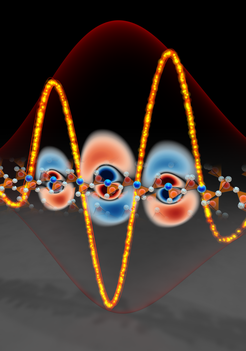A switch for light wave electronics
A team of scientists optimized the interaction of light and glass in a way that facilitates its possible future usage for light wave driven electronics.

Electron movements form the basis of electronics as they facilitate the storage, processing and transfer of information. State-of-the-art electronic circuits have reached their maximum clock rates at some billion switching cycles per second as they are limited by the heat accumulating in the process of switching power on and off.
The electric field of light changes its direction a trillion times per second and is able to move electrons in solids at this speed. This means that light waves can form the basis for future electronic switching if the induced electron motion and its influence on heat accumulation is precisely understood. Physicists from the Laboratory for Attosecond Physics at the MPQ and the LMU already found out that it is possible to manipulate the electronic properties of matter at optical frequencies (Nature, doi: 10.1038/nature11567, Nature, doi: 10.1038/nature11720, both published 5.Dezember 2012).
In a follow-up experiment the researchers now, in a similar way as in their previous approach, shot extremely strong, few femtosecond- laser pulses (one femtosecond is a millionth part of a second) onto glass (silicon dioxide). The light pulse only includes one single strong oscillation cycle of the field, hence the electrons are moved left and right only once. The full temporal characterization of the light field after transmission through the thin glass plate now for the first time provides direct insight into the attosecond electron dynamics, induced by the light pulse in the solid.
This measurement technique reveals that electrons react with a delay of only some ten attoseconds (one attosecond is a billionth of a billionth of a second) to the incoming light. This time-delay in the reaction determines the energy transferred between light and matter. Since it is possible to measure this energy exchange within one light cycle for the first time the parameters of the light matter interaction can be understood and optimized for ultimate fast signal processing. The more reversible the exchange is and the smaller the amount of energy which is left behind in the medium after the light pulse is gone, the better the interaction is suitable for future light field-driven electronics.
To understand the observed phenomena and identify the best set of experimental parameters to that end, the experiments were backed up by a novel simulation method based on first principles developed at the Center for Computational Sciences at University of Tsukuba. The theorists there used the K computer, currently the 4-th fastest supercomputer in the world to compute the electron movement inside solids with unprecedented accuracy.
The researchers succeeded in optimizing the energy consumption by adapting the amplitude of the light field. At certain field strengths energy is transferred from the field to the solid during the first half of the pulse cycle and is almost completely emitted back in the second half of the light. These findings verify that a potential switching medium for future light-driven electronics would not overheat. The ’cool relationship’ between glass and light might provide an opportunity to dramatically accelerate electronic signal- and data processing, up to its ultimate frontiers. Thorsten Naeser












